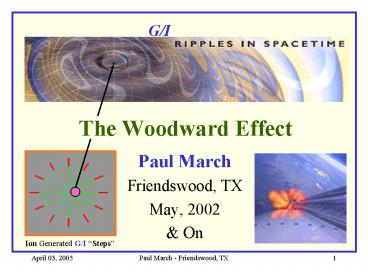Paul March - PowerPoint PPT Presentation
1 / 13
Title: Paul March
1
The Woodward Effect
G/I
- Paul March
- Friendswood, TX
- May, 2002
- On
Ion Generated G/I Steps
2
There Are Three Categories of Breakthrough
Propulsion Physics (BPP)
- Wormholes and Warp Bubbles that enable FTL
travel (and thus time machines). - Prompt, near lightspeed travel (that, like WWB,
requires the generation of exotic gravitational
matter to reduce the masses of vehicles). - Propellantless Propulsion (P-P) schemes that
involve the production of accelerating forces
without the expulsion of propellant. - J. F. Woodward
3
Propellantless Propulsion (P-P) Things to Look
For
- Does the P-P rely on local or remote (inside or
outside the SRT light cone) momentum exchange? - How does the scheme account for coupling to the
distant matter in the universe (relative to which
all accelerations take place)? J. F. Woodward - How are the minuscule alleged effects (normally
never seen) promoted into effects large enough to
have practical value? J. F. Woodward - How is momentum conserved?
- J. F. Woodward
4
Dr. James F. Woodward California State
University Fullerton Campus Professor of
History (1972)Adjunct Professor of
Physics A.B., Middlebury College, 1964
(Physics)M.S., New York University, 1969
(Physics)Ph.D., University of Denver, 1972
(History) Office Humanities - H-810lLab
McCarthy Hall - MH-601Phone (714)
278-3167/(714) 278-3596FAX (714)
278-5810email jwoodward _at_ fullerton.edu
5
An Electric Motor to the Stars?
- If one built a flat electric motor with a flat
stationary section, the Linear Stator, and a
flat movable section, the Linear Rotor and
attached the Rotor to a vehicle, one would then
have vehicular MAGnetic LEVitation or MAGLEV. - If one replaced the MAGLEV Stator with
Gravitational / Inertial (G/I) induced Ripples
In Space-Time (RIST) that could cyclically
change the mass of the stator and then change the
MAGLEV rotor into a device called a
Unidirectional Force Generator (UFG) that could
convert those mass fluctuations into a constant
force, one would then have a G/I-UFG that could
give us the solar system ultimately the stars.
Stator
Rotor
Rotor
Stator
UFG
G/I-RIST
- That is the goal of this presentation. To
present the necessary background, motivation and
basic principals that will lay the foundations
for building a G/I-UFG Propellantless Propulsion
(P-P) powered vehicle.
6
What Data Supports the W-E Approach to
Propelantless Propulsion?
- On page-7 you will find the culmination of
13-years into the realm of experimental Physics
that produced 1.5 grams of weight reduction for
2-seconds utilizing 400 watts of 66.6 kHz ac
input power into a piezoelectric UFG device. - Longer times of up to six seconds and higher
weight reductions have been obtained (2.3g), but
the following CY2001 chart provides the cleanest
data. - Woodward and later Mahood, designed, built and
tested several generations of test hardware over
this time period. - After CY2002, Woodward March pursued another
approach using magnetic fields to force rectify
Woodwards mass fluctuations into useful thrust.
7
Woodwards UFG U-80 Load Cell Data
Averaged 66.6 kHz IIT Report Weight Reduction
Signal
Weight Signal
PZT Temperature
66.6 kHz Input Power
8
Woodwards UFG U-80 Force Transducer Test Rig
Schematic (1998)
(0.19685 ohms per micron travel)
9
What Data Supports the W-E Approach to
Propelantless Propulsion? (Cont.)
- During these tests, much effort went into peer
review, error control, procedure inversions, etc.
to verify that the measured effect was real and
not a measurement artifact. This work continues
and continues to provide positive results. - The rest of this presentation will try to answer
the questions of how and why these weight
reductions and the generation of forces can
occur, how we can build Unidirectional Force
Generators (UFGs) and Mach-Lorentz Thrusters, and
what we could do with them.
10
Woodwards 1998 CSUF Test Setup(On the Sixth
floor of CSUF Science Building)
11
1999 CSUF Torque Pendulum Work
Tom Mahood, (Left) was Woodwards Graduate
Student From 1998 to 1999 A small force in the
above torque pendulum While operating in a
vacuum was detected, where none should have been.
12
Woodwards 2003 Mach-3A 50kHz Test Article
Mach-3A was operated in an open-ended,
non-resonant mode. Doorknob Cap E ½ CV2 ½
(11x10-9 1,200Vp2) 0.00792 Joules into 4.379
cm3 x 2 0.0009043 J/cm3 Or 0.00792J / 47.8gr
Active Mass 1.657x10-4 J/gr
Two Wire (GRN BRN) Bifilar Bundle 1 with five,
60-turn Bifilar layers totaling 300 turns per
toroid side, while maintaining the magnetic
field additive coil winding sense for each
layer.
230 uh
0.75 Amps / wire
Trimmed Cap Active Mass 5.5/6.05 x 26.28 gr
23.9 grams each Density 6.01 gr / cm3
1.65cm
Bifilar Bundle 1
3-to-4-amps
460 uh
230 uh
Caps Er 9,000 Qty. 2, trimmed Caps 5.5 nF _at_
15kVdc Ceramic Caps in Parallel 11.0 nF _at_
15kVdc 2.705cm OD x 0.762cm Thick, 6.05nF, Active
Mass 26.3g, Total Mass30.8g each
Bifilar Bundle 2
13
Woodwards Mahoods Family of UFGs































